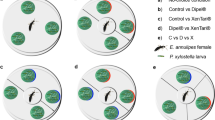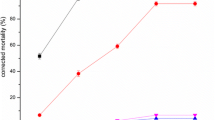Abstract
In the current study, we have designed two experimental devices to study the potential of Metarhizium brunneum (Petch) and its crude extract (filtered growth medium) for the control of Drosophila suzukii (Matsumura). An experimental autoinoculation device impregnated with conidia of EAMa 01/58-Su strain was designed for a lure-and-infect strategy. D. suzukii adult mortality resulted in a 62.2% with an average survival time of 3.6 days, with no significant differences among attractiveness to adults of red and black colours used in the devices. Nevertheless, a 48.0% mortality of untreated males was obtained after being coupled with inoculated females, whereas only 24.0% of untreated females was killed after being coupled with inoculated males, thereby revealing the horizontal transmission potential of the strain in these inoculation devices. We observed an 84.7% reduction in fecundity in M. brunneum-challenged D. suzukii females. Finally, we designed a lure-and-kill device to dispense a crude extract of the EAMb 09/01-Su strain that had previously shown acute mortality in D. suzukii, with an exposure time of 6.9 h required to achieve 50.0% mortality. Mixing the extract with feeding attractant caused a 61.6% D. suzukii adult mortality rate. These results show the high potential of using M. brunneum in lure-and-infect and lure-and-kill strategies contributing to an integrated pest management program for D. suzukii control.



Similar content being viewed by others
References
Arnó J, Solà M, Riudavets J, Gabarra R (2016) Population dynamics, non-crop hosts and fruit susceptibility of Drosophila suzukii in Northeast Spain. J Pest Sci 89(3):713–723
Asplen MK, Anfora G, Biondi A, Choi DS, Chu D, Daane KM, Gibert P, Gutierrez AP, Hoelmer KM, Hutchison WD, Isaacs R, Jiang ZL, Kárpáti Z, Kimura MT, Pascual M, Philips CR, Plantamp C, Ponti L, Vétek G, Vogt H, Walton VM, Yu Y, Zappalá L, Desneux N (2015) Invasion biology of spotted wing Drosophila (Drosophila suzukii): a global perspective and future priorities. J Pest Sci 88:469–494
Bolda MP, Goodhue RE, Zalom FG (2010) Spotted wing Drosophila: potential economic impact of a newly established pest. Agric Res Econ 13:5–8
Calabria G, Máca J, Bächli G, Serra L, Pascual M (2012) First records of the potential pest species Drosophila suzukii (Diptera: Drosophilidae). Eur J Appl Entomol 136:139–147
Centre for Agriculture and Biosciences International (CABI) (2016) Drosophila suzukii (spotted wing drosophila). http://www.cabi.org/isc/datasheet/109283
Cini A, Ioriatti C, Anfora G (2012) A review of the invasion of Drosophila suzukii in Europe and a draft research agenda for integrated pest management. Bull Insectol 65(1):149–160
Cini A, Anfora G, Escudero-Colomar LA, Grassi A, Santosuosso U, Seljak G, Papini A (2014) Tracking the invasion of the alien fruit pest Drosophila suzukii in Europe. J Pest Sci 87:559–566
Cossentine J, Robertson M, Xu D (2016) Biological activity of Bacillus thuringiensis in Drosophila suzukii (Diptera: Drosophilidae). J Econ Entomol 109(3):1071–1078
Cuthbertson AGS, Audsley N (2016) Further screening of entomopathogenic fungi and nematodes as control agents for Drosophila suzukii. Insects. doi:10.3390/insects7020024
Cuthbertson AGS, Collins DA, Blackburn LF, Audsley BellHA (2014) Preliminary screening of potential control products against Drosophila suzukii. Insects 5(2):488–498
Daane KM, Wang XG, Bondi A, Miller JC, Miller BE et al (2016) First exploration of Asian parasitoids of Drosophila suzukii in South Korea as potential biological control agents. J Pest Sci 89:823–835
Dalton DT, Walton VM, Shearer PW, Walsh DB, Caprile J, Isaacs R (2011) Laboratory survival of Drosophila suzukii under simulated winter conditions of the Pacific Northwest and seasonal field trapping in five primary regions of small and stone fruit production in the United States. Pest Manag Sci 67:1368–1374
Dekker T, Revadi S, Mansourian S, Ramasamy S, Lebreton S, Becher PG, Angeli S, Rota-Stabelli O, Anfora G (2015) Loss of Drosophila pheromone reverses its role in sexual communication in Drosophila suzukii. Proc R Soc B 282:20143018
Diepenbrock LM, Hardin J, Burrack HJ (2015) Efficacy of Insecticides Against Drosophila suzukii (Diptera: Drosophilidae) in Blueberries, 2014. Arthropod Manag Tests 40(1):1–3
Diepenbrock LM, Swoboda-Bhattarai KA, Burrack HJ (2016) Ovipositional preference, fidelity, and fitness of Drosophila suzukii in a co-occurring crop and non-crop system. J Pest Sci 89(3):761–769
Dreves AJ, Langellotto-Rhodaback GA (2011) Protecting garden fruit from Spotted Wing Drosophila. Oregon State University Extension Publication EM 9026
Ekesi S, Dimbi S, Maniania NK (2007) The role of entomopathogenic fungi in the integrated management of fruit flies (Diptera: Tephritidae) with emphasis on species occurring in Africa. In: Ekesi S, Maniana NK (eds) Use of entomopathogenic fungi in biological pest management. Research Sign Posts, Trivandrum, pp 239–274
Emiljanowicz LM, Ryan GD, Langille A, Newman J (2014) Development, reproductive output and population growth of the fruit fly pest Drosophila suzukii (Diptera: Drosophilidae) on artificial diet. J Econ Entomol 107(4):1392–1398
Eriksson A, Anfora G, Lucchi A, Lanzo F, Virantdoberlet M, Mazzoni V (2012) Exploitation of insect vibrational signals reveals a new method of pest management. PLoS ONE 7(3):e32954
Hamby KA, BellamyDE ChiuJC, Lee JC, Walton VM, Wiman NG, York RM, Biondi A (2016) Biotic and abiotic factors impacting development, behavior, phenology, and reproductive biology of Drosophila suzukii. J Pest Sci 89:605–619
Haye T, Girod P, Cuthbertson AGS, Wang XG, Daane KM, Hoelmer KA, Baroffio C, Zhang JP, Desneux N (2016) Current SWD IPM tactics and their practical implementation in fruit crops across different regions around the world. J Pest Sci 89(3):643–651
Kawase S, Uchino K (2005) Effect of mesh size on Drosophila suzukii adults passing through the mesh. Ann Rep Kanto-Tosan Plant Prot 52:99–101
Kenis M, Tonina L, Eschen R, van der Sluis B, Sancassani M, Mori N, Haye T, Helsen H (2016) Non-crop plants used as hosts by Drosophila suzukii in Europe. J Pest Sci 89(3):735–748
Kirkpatrick DM, McGhee PS, Hermann SL, Gut LJ, Miller JR (2016) Alightment of spotted wing Drosophila (Diptera: Drosophilidae) on odorless disks varying in color. Environ Entomol 45(1):185–191
Lee JC, Bruck DJ, Curry H, Edwards D, Haviland DR, Steenwyk RAV, Yorgey BM (2011) The susceptibility of small fruits and cherries to the spotted wing drosophila, Drosophila suzukii. Pest Manag Sci 67(11):1358–1367
Littell RC, Milliken GA, Stroup WW, Wolfinger RD, Schabenberger O (2006) SAS for mixed models, 2nd edn. SAS Institute Inc, NC
Ministerio de Agricultura, Alimentación, y Medio Ambiente (MAGRAMA) (2017) www.magrama.gob.es/es/. Accessed 27 March 2017
Naranjo-Lázaro JM, Mellín-Rosas MA, González-Padilla VD, Sánchez-González JA, Moreno-Carrillo G, Arredondo-Bernal HC (2014) Susceptibility of Drosophila suzukii Matsumura (Diptera: Drosophilidae) to entomophatogenic fungi. Southwest Entomol 39(1):201–203
Ortiz-Urquiza A, Rivero-Miranda L, Santiago-Álvarez C, Quesada-Moraga E (2010) Insect-toxic secreted proteins and virulence of the entomopathogenic fungus Beauveria bassiana. J Invertebr Pathol 105:270–278
Quesada-Moraga E, Santiago-Álvarez C (2008) Capítulo 7. Hongos entomopatógenos. In: Jacas JA, Urbaneja A (eds) Control biológico de plagas agrícolas. Phytoma, España, pp 98–120
Quesada-Moraga E, Ruiz-García A, Santiago-Álvarez C (2006) Laboratory evaluation of entomopathogenic fungi Beauveria bassiana and Metarhizium anisopliae against puparia and adults of Ceratitis capitata (Diptera: Tephritidae). J Econ Entomol 99(6):1955–1966
Quesada-Moraga E, Martin-Carballo I, Garrido-Jurado I, Santiago-Álvarez C (2008) Horizontal transmission of Metarhizium anisopliae among laboratory populations of Ceratitis capitata (Wiedemann) (Diptera: Tephritidae). Biol Control 47:115–124
Rogers MA, Burkness EC, Hutchison WD (2016) Evaluation of high tunnels for management of Drosophila suzukii in fall-bearing red raspberries: potential for reducing insecticide use. J Pest Sci 89:815–821
Walsh DB, Bolda MP, Goodhue RE, Dreves AJ, Lee J, Bruck DJ, Walton VM, ÓNeal SD, Zalom FG (2011) Drosophila suzukii (Diptera: Drosophilidae): invasive pest of ripening soft fruit expanding its geographic range and damage potential. Integ Pest Manag. doi:10.1603/IPM10010
Woltz JM, Donahue KM, Bruck DJ, Lee JC (2015) Efficacy of commercially available predators, nematodes and fungal entomopathogens for augmentative control of Drosophila suzukii. J Appl Entomol 139(10):759–770
Yousef M, Lozano-Tovar MD, Garrido-Jurado I, Quesada-Moraga E (2013) Biocontrol of Bactrocera oleae (Diptera: Tephritidae) with Metarhizium brunneum and its extracts. J Econ Entomol 106(3):1118–1125
Yousef M, Garrido-Jurado I, Quesada-Moraga E (2014) One Metarhizium brunneum strain, two uses to control Ceratitis capitata (Diptera: Tephritidae). J Econ Entomol 107(5):1736–1744
Yousef M, Quesada-Moraga E, Garrido-Jurado I (2015) Compatibility of herbicides used in olive orchards with a Metarhizium brunneum strain used for the control of preimaginal stages of tephritids in the soil. J Pest Sci 88(3):605–612
Yousef M, Garrido-Jurado I, Ruiz-Torres M, Quesada-Moraga E (2017) Reduction of adult olive fruit fly populations by targeting preimaginals in the soil with the entomopathogenic fungus Metarhizium brunneum. J Pest Sci 90:345–354
Zapata N, Budia F, Vinuela E, Medina P (2006) Insecticidal effects of various concentrations of selected extractions of Cestrum parqui on adult and immature Ceratitis capitata. J Econ Entomol 99:359–365
Acknowledgements
This research was supported by the Spanish Ministry of Economy and Competitiveness project AGL2016-80483-R. The authors thank Dr. Rosa Gabarra, IRTA-Centre de Cabrils for providing the D. suzukii population and Ma del Carmen Fernández Bravo for establishment and maintaining of D. suzukii stock colony. Furthermore, the authors wish to thank Pablo Valverde-García for his assistance with the statistical analysis.
Author information
Authors and Affiliations
Corresponding author
Ethics declarations
Conflict of interest
The authors declare that they have no competing interests.
Ethical standard
This article does not describe any studies that involve human participants. All applicable international, national, and/or institutional guidelines for the care and use of animals were followed.
Additional information
Communicated by A. Biondi.
Electronic supplementary material
Below is the link to the electronic supplementary material.
Rights and permissions
About this article
Cite this article
Yousef, M., Aranda-Valera, E. & Quesada-Moraga, E. Lure-and-infect and lure-and-kill devices based on Metarhizium brunneum for spotted wing Drosophila control. J Pest Sci 91, 227–235 (2018). https://doi.org/10.1007/s10340-017-0874-8
Received:
Revised:
Accepted:
Published:
Issue Date:
DOI: https://doi.org/10.1007/s10340-017-0874-8




